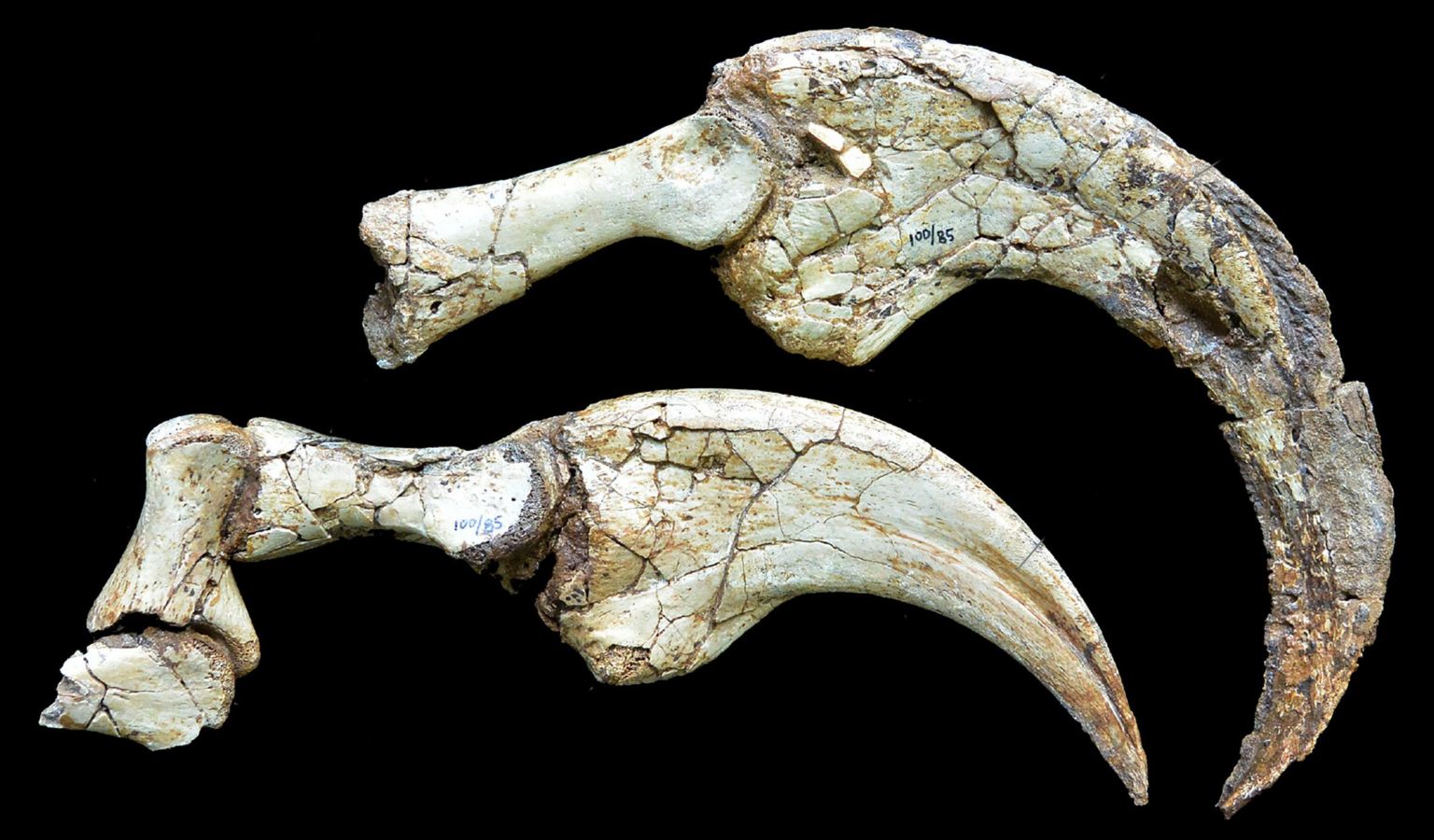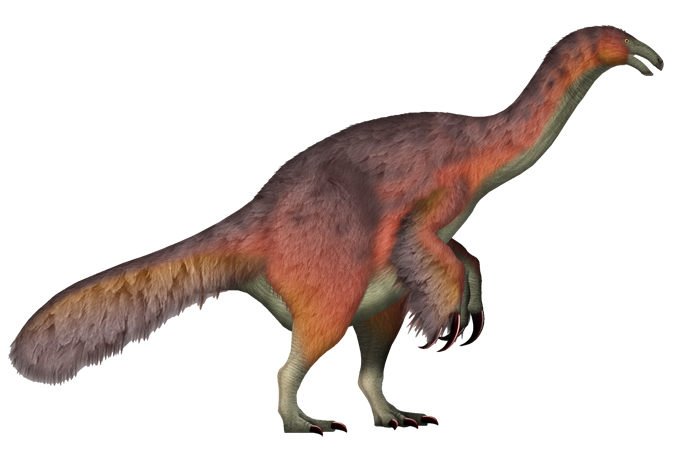Science
Related: About this forumHuge fossilised claws discovered by scientists belong to mysterious new species
Harry Fletcher
May 03, 2025
A set of huge, fossilised claws were discovered by archaeologists, offering remarkable insight into a fascinating creature – and dinosaur fans, you’re going to want to see this.
The massive pair of talons were found in the Gobi Desert in southeastern Mongolia and the fossilised remains offer us a glimpse at a brand new species never seen before by scientists.
The two fingers found both have keratin on the outer layer acting as a sheath, with bones underneath extending as talons.
The claws measure almost 30 centimeters long, and we certainly wouldn’t want to get on the wrong side of it, we’ll say that much.
The “herbivorous or omnivorous” creature was named Duonychus tsogtbaatari and experts were able to hypothesise that the claws were used to latch onto vegetation.
Paleontologist Yoshitsugu Kobayashi from Hokkaido University in Japan led the team behind the discovery in 2012, with the "exceptionally preserved and atypical hands” presenting a remarkable find. The research was published in iScience.
More:
https://www.indy100.com/science-tech/huge-claws-dinosaur-fossil-species-discovered
Brother Buzz
(39,253 posts) .
.Judi Lynn
(163,984 posts)Volume 28, Issue 4112141April 18, 2025
Yoshitsugu Kobayashi1,6 ykobayashi@museum.hokudai.ac.jp ∙ Darla K. Zelenitsky2 ∙ Anthony R. Fiorillo3 ∙ Tsogtbaatar Chinzorig4,5
Summary
Therizinosaurs were a group of herbivorous/omnivorous theropod dinosaurs that lived in Asia and North America during the Cretaceous Period. These theropods are notable for their three-fingered hands sporting large claw-like unguals. Here, we describe a new and unusual species of the therizinosaurid Duonychus tsogtbaatari, recovered from the lower Upper Cretaceous Bayanshiree Formation of the Gobi Desert of Mongolia. This species is different from other therizinosaurs in that the hand possesses only two fingers, rather than three fingers, the typical condition for Avetheropoda, providing further insight into forelimb/hand reduction among theropods. Phylogenetically, Duonychus reveals a broader but still limited appearance of didactyly among avetheropodans. The manual ungual of Duonychus tsogtbaatari also preserves a nearly complete three-dimensional structure covering the ungual of the left manual digit I, which represents a keratinous manual claw. The strong curvature of this large claw and high ungual flexion indicate that Duonychus was likely amplectorial (grasping) and an effective grasper of vegetation, despite having only two functional fingers.
Graphical abstract

Introduction
Therizinosauria is a clade of unusual herbivorous or omnivorous theropod dinosaurs known from Cretaceous deposits of Asia and North America. This clade is most recognizable for their tridactyl (three-fingered) hands sporting three large claw-like unguals, as exemplified by the large-bodied Therizinosaurus from the latest Cretaceous of Mongolia.1,2,3 More primitive members of the clade like Falcarius,4 Beipiaosaurus,5 and Jianchangosaurus6 had relatively smaller unguals compared to more derived forms, such as Erliansaurus,7 Nothronychus,8,9 and especially Therizinosaurus.1,2 As herbivorous or omnivorous theropods with long necks5,8,10 and small leaf-shaped teeth,11,12,13 the evolution of their unusual hands likely played an important role in the feeding ecology of this clade.14,15
Although the manus is quite distinct in therizinosaurs, specimens with relatively complete hands are not overly common in the fossil record.15 Of the known therizinosaur species where the manus is relatively well preserved (including Falcarius,4 Beipiaosaurus,5 Jianchangosaurus,6 Erliansaurus,7 Nothronychus,8 and Therizinosaurus1,2), they all possess three digits, which is the primitive and typical condition of avetheropods. In derived therizinosaurs, these digits and relatively large unguals (i.e., large relative to the preceding/penultimate phalanx) are considered to have performed a hook-and-pull function for grasping branches to bring to the mouth during feeding.14,15 The keratinous claws covering the unguals in life also would have affected manus function, but these structures, which are much less prone to fossilization than the bony unguals, have yet to be reported in therizinosaurs.
Here, we describe a new therizinosaur taxon, Duonychus tsogtbaatari, based on a specimen that has exceptionally preserved and atypical hands, recovered from the Upper Cretaceous Bayanshiree Formation (Cenomanian to Santonian) in Ömnögovi Province, southeastern Mongolia (Figure 1). With respect to other therizinosaurs, this new taxon is unique in possessing a definitive didactyl (two-fingered) hand; the specimen also novelly (among non-paravian theropods) preserves a complete, three-dimensional sheath representing the keratinous claw. Consequently, Duonychus tsogtbaatari provides insight into the evolution of digit reduction among avetheropods and reveals feeding behavioral implications associated with the large claws in therizinosaurs.
More:
https://www.cell.com/iscience/fulltext/S2589-0042(25)00401-8
~ ~ ~
Unique, New Therizinosaur is Named
Scientists have named a unique, two-fingered therizinosaur species. The fossils of Duonychus tsogtbaatari come from the Upper Cretaceous Bayanshiree Formation of the Gobi Desert (Mongolia). This is the first time that a reduction of the digits on the manus has been recorded within the Therizinosauridae family. All other therizinosaurs possessed three fingers on each hand. Moreover, each finger ended in a curved claw. Some of the claws of therizinosaurs were huge. For example, one of the largest, Therizinosaurus cheloniformis had finger claws over a metre in length.

A life reconstruction of Duonychus tsogtbaatari. This dinosaur had two fingers on each hand. Although the fossils from which this new species has been described represent a subadult. Scientists have calculated that It weighed approximately 260 kilograms and was around three metres in length. Picture credit: Tim Bollinger.
Picture credit: Tim Bollinger
Duonychus tsogtbaatari
Duonychus (pronounced due-oh-ny-kus) translates from the Greek as “two claws”. The species name honours the Mongolian palaeontologist Khishigjav Tsogtbaatar. The discovery of this therizinosaur is doubly unique. One of the sheaths on a fossil claw (digit I) has been preserved. The sheath made from the protein keratin (same as our hair and fingernails), reveals that the claw was much longer than the underlying bone. It was forty percent longer than the claw’s bony core. It is the largest claw of its kind found fully preserved in this way. The total claw length has been estimated at around thirty centimetres.
Duonychus tsogtbaatari was not carnivorous. These long claws were probably not used to attack other dinosaurs. Although, they could have had a defensive function or have been used in intraspecific combat. The researchers studying the fossil material believe the long, curved claws and the ability of Duonychus to flex them would have helped this animal to grasp vegetation.

Duonychus tsogtbaatari data card. Picture credit: Tim Bollinger.
Digit Reduction in Theropod Dinosaurs
The most famous two-fingered theropod dinosaur is Tyrannosaurus rex. Duonychus is not closely related to T. rex. However, both these dinosaurs evolved from ancestors that had three digits on each hand. So, why did some theropod dinosaurs lose digits? It is likely that the outer fingers of the hand became less useful and so they were gradually reduced over the time. An evolutionary pathway led to the outer fingers becoming redundant, then vestigial, before finally disappearing altogether. Alternatively, digits I and II became increasingly dominant and thus enlarged. This led to the eventual reduction and elimination of digit III.
More:
https://blog.everythingdinosaur.com/blog/_archives/2025/03/28/unique-new-therizinosaur-is-named.html
Warpy
(114,130 posts)Gigantic dinosaur proto-kittycat? It will be interesting if they discover more of it or its relatives. It will be interesting to feed the data into a computer to see what the clade shows and what its descendants might be.
After all, it's only recently that we found out that the closest living relative of T. Rex is the modern chicken.
chouchou
(2,552 posts)Linda ladeewolf
(1,008 posts)I guess if you consider the tiny rat or possum like critters we are distantly related to as humans. They existed back then, don’t ask me how far back.(spoken in Walter Brennan’s voice) My Great…………..Uncle Possum knew a-T-Rex that was a little near sighted once. That’s how he avoided being eaten by old Rexy.
chouchou
(2,552 posts)They "Show" stuff like Humans riding on T-Rex. The earth is flat. We never went to the Moon...and tons of other loony crap.
I was just warning that another round of "Oh Brother" will be pasted on Reels. The Nuts take up space... ![]()
Linda ladeewolf
(1,008 posts)On the web archive, a few months ago. There is a lot of looneys on there. It was a film of the astronauts all right, a training film done outside Las Vegas! I remember seeing the same film in grade school when we had a science class, they kept saying it was the faked moon landing. They did several of those with the astronauts for publicity as well, The nuts keep saying it was all AI or CGI, they don’t seem to take into account that we didn’t have those things back then. The only way we had film of the moon was actually making it.
As for dinosaurs ever meeting a human, it is highly unlikely, I believed they watched the flintstones and thought it was a documentary.